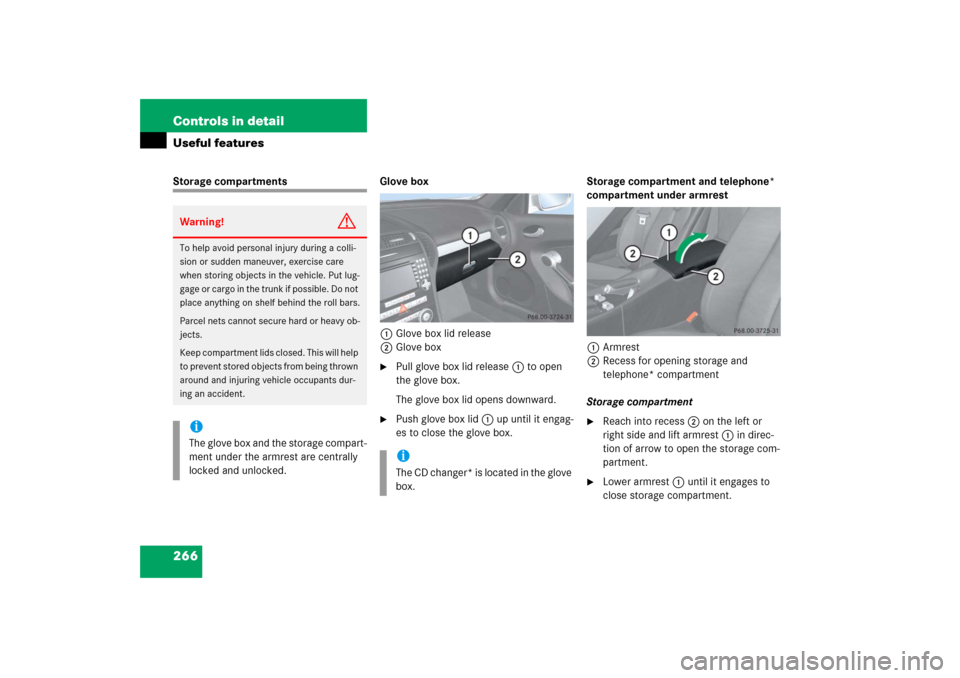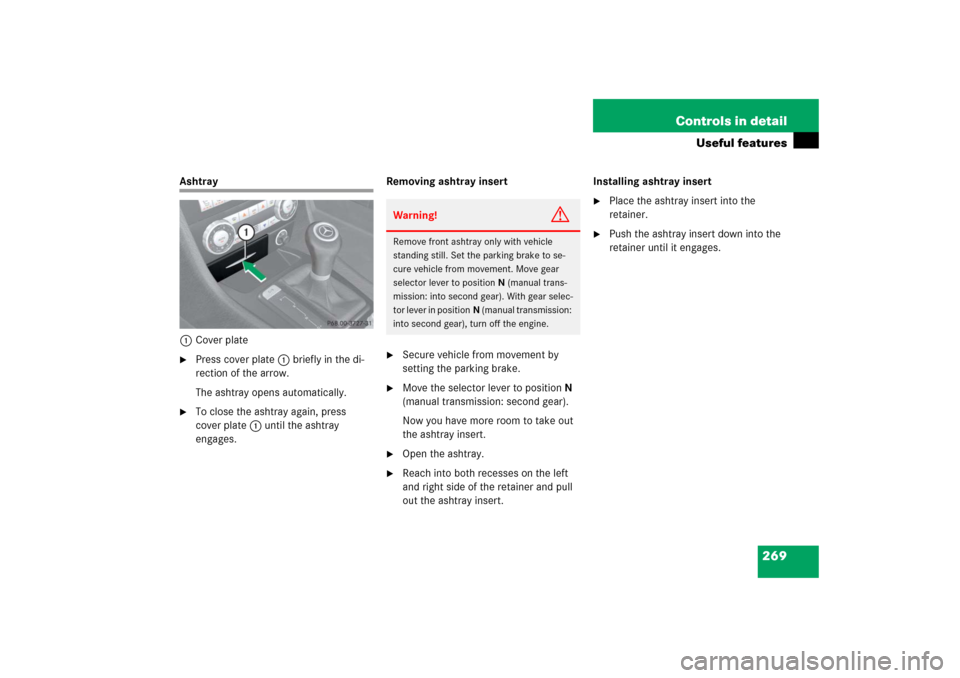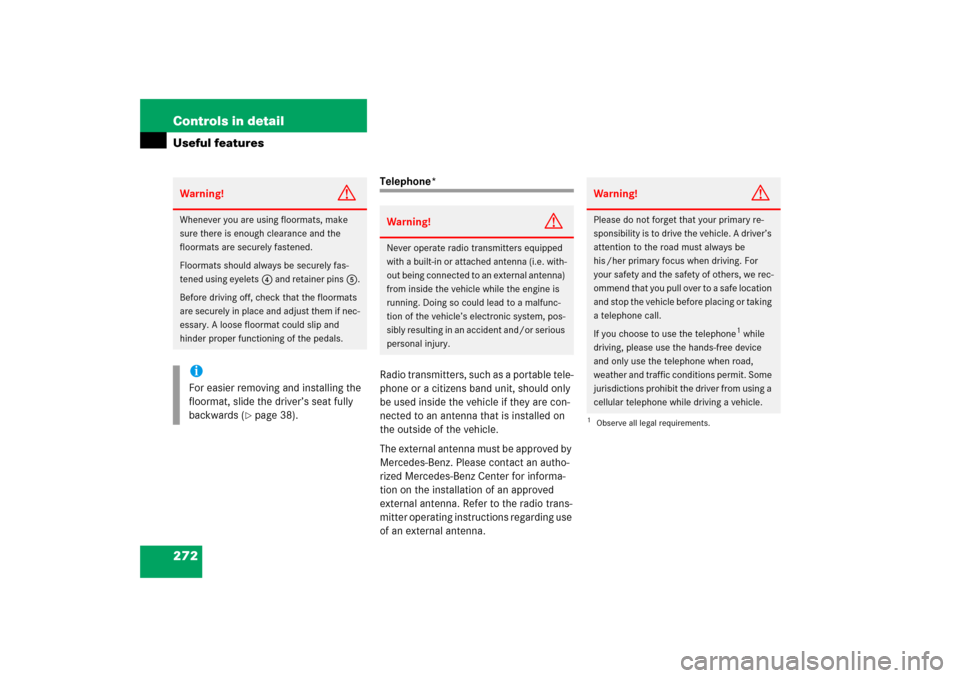Page 261 of 481

260 Controls in detailDriving systemsThe driving system of your vehicle is
described on the following pages:�
Cruise control, with which the vehicle
can maintain a preset speed.
The BAS, ABS and ESP
® driving systems
are described in the “Safety and Security”
section (
�page 82).
Cruise control
The cruise control automatically maintains
the speed you set for your vehicle.
Use of cruise control is recommended for
driving at a constant speed for extended
periods of time.
You can set or resume cruise control at any
speed over 20 mph (30 km/h).
The cruise control function is operated by
means of the cruise control lever.
The cruise control lever is the uppermost
lever on the left-hand side of the steering
column (
�page 22).
Warning!
G
The cruise control is a convenience system
designed to assist the driver during vehicle
operation. The driver is and must remain at
all times responsible for the vehicle speed
and for safe brake operation.
Only use the cruise control if the road,
traffic, and weather conditions make it
advisable to travel at a steady speed.�
The use of cruise control can be danger-
ous on winding roads or in heavy traffic
because conditions do not allow safe
driving at a steady speed.
�
The use of cruise control can be danger-
ous on slippery roads. Rapid changes in
tire traction can result in wheel spin and
loss of control.
�
Deactivate the cruise control when driv-
ing in fog.
The “Resume” function should only be oper-
ated if the driver is fully aware of the previ-
ously set speed and wishes to resume this
particular preset speed.
Page 267 of 481

266 Controls in detailUseful featuresStorage compartments Glove box
1Glove box lid release
2Glove box
�
Pull glove box lid release1 to open
the glove box.
The glove box lid opens downward.
�
Push glove box lid1 up until it engag-
es to close the glove box.Storage compartment and telephone*
compartment under armrest
1Armrest
2Recess for opening storage and
telephone* compartment
Storage compartment
�
Reach into recess2 on the left or
right side and lift armrest1 in direc-
tion of arrow to open the storage com-
partment.
�
Lower armrest1 until it engages to
close storage compartment.
Warning!
G
To help avoid personal injury during a colli-
sion or sudden maneuver, exercise care
when storing objects in the vehicle. Put lug-
g a g e o r c a r g o i n t h e t r u n k i f p o s s i b l e . D o n o t
place anything on shelf behind the roll bars.
Parcel nets cannot secure hard or heavy ob-
jects.
Keep compartment lids closed. This will help
to prevent stored objects from being thrown
around and injuring vehicle occupants dur-
ing an accident.iThe glove box and the storage compart-
ment under the armrest are centrally
locked and unlocked.
iThe CD changer* is located in the glove
box.
Page 270 of 481

269 Controls in detail
Useful features
Ashtray
1Cover plate�
Press cover plate1 briefly in the di-
rection of the arrow.
The ashtray opens automatically.
�
To close the ashtray again, press
cover plate1 until the ashtray
engages.Removing ashtray insert
�
Secure vehicle from movement by
setting the parking brake.
�
Move the selector lever to positionN
(manual transmission: second gear).
Now you have more room to take out
the ashtray insert.
�
Open the ashtray.
�
Reach into both recesses on the left
and right side of the retainer and pull
out the ashtray insert.Installing ashtray insert
�
Place the ashtray insert into the
retainer.
�
Push the ashtray insert down into the
retainer until it engages.
Warning!
G
Remove front ashtray only with vehicle
standing still. Set the parking brake to se-
cure vehicle from movement. Move gear
selector lever to positionN (manual trans-
mission: into second gear). With gear selec-
tor lever in positionN (manual transmission:
into second gear), turn off the engine.
Page 273 of 481

272 Controls in detailUseful features
Telephone*
Radio transmitters, such as a portable tele-
phone or a citizens band unit, should only
be used inside the vehicle if they are con-
nected to an antenna that is installed on
the outside of the vehicle.
The external antenna must be approved by
Mercedes-Benz. Please contact an autho-
rized Mercedes-Benz Center for informa-
tion on the installation of an approved
external antenna. Refer to the radio trans-
mitter operating instructions regarding use
of an external antenna.
Warning!
G
Whenever you are using floormats, make
sure there is enough clearance and the
floormats are securely fastened.
Floormats should always be securely fas-
tened using eyelets4 and retainer pins5.
Before driving off, check that the floormats
are securely in place and adjust them if nec-
essary. A loose floormat could slip and
hinder proper functioning of the pedals.iFor easier removing and installing the
floormat, slide the driver’s seat fully
backwards (
�page 38).
Warning!
G
Never operate radio transmitters equipped
with a built-in or attached antenna (i.e. with-
out being connected to an external antenna)
from inside the vehicle while the engine is
running. Doing so could lead to a malfunc-
tion of the vehicle’s electronic system, pos-
sibly resulting in an accident and/or serious
personal injury.
Warning!
G
Please do not forget that your primary re-
sponsibility is to drive the vehicle. A driver’s
attention to the road must always be
his /her primary focus when driving. For
your safety and the safety of others, we rec-
ommend that you pull over to a safe location
and stop the vehicle before placing or taking
a telephone call.
If you choose to use the telephone
1 while
driving, please use the hands-free device
and only use the telephone when road,
weather and traffic conditions permit. Some
jurisdictions prohibit the driver from using a
cellular telephone while driving a vehicle.
1Observe all legal requirements.
Page 302 of 481

301 Operation
Driving instructions
Passenger compartmentDriving abroad
Abroad, there is an extensive
Mercedes-Benz service network at your
disposal. If you plan to drive into areas
which are not listed in the index of your
Mercedes-Benz Center directory, you
should request pertinent information from
an authorized Mercedes-Benz Center.Control and operation of radio
transmitter
COMAND*, radio, and telephone*Telephones and two-way radios
Radio transmitters, such as a portable tele-
phone or a citizens band unit should only
be used inside the vehicle if they are con-
nected to an antenna that is installed on
the outside of the vehicle.
Refer to the radio transmitter operation in-
structions regarding use of an external
antenna.
Warning!
G
Always fasten items being carried as secure-
ly as possible.
In an accident, during hard braking or sud-
den maneuvers, loose items will be thrown
around inside the vehicle, and cause injury
to vehicle occupants unless the items are
securely fastened in the vehicle.
The trunk is the preferred place to carry ob-
jects.
Warning!
G
Please do not forget that your primary re-
sponsibility is to drive the vehicle safely.
Only operate the COMAND*, radio or tele-
phone
1 if road, traffic and weather condi-
tions permit.
Bear in mind that at a speed of just 30 mph
(approximately 50 km/h), your vehicle is
covering a distance of 44 feet
(approximately 14 m) every second.
1Observe all legal requirements.
Warning!
G
Never operate radio transmitters equipped
with a built-in or attached antenna (i.e. with-
out being connected to an external antenna)
from inside the vehicle while the engine is
running. Doing so could lead to a malfunc-
tion of the vehicle’s electronic system, pos-
sibly resulting in an accident and/or
personal injury.
Page 391 of 481
390 Practical hintsWhere will I find...?Operational position�
Turn crank handle clockwise.
Before storing the vehicle jack in its
compartment:
�
It should be fully collapsed.
�
The handle must be folded in (storage
position).Setting up the collapsible wheel chock
The collapsible wheel chock serves to ad-
ditionally secure the vehicle, e.g. while
changing the wheel.
1Tilt the plate upward
2Fold the lower plate outward
3Insert the plate
�
Tilt both plates upward1.
�
Fold the lower plate outward2.
�
Guide the tabs of the lower plate all the
way into the openings of the base
plate3.
Page 392 of 481

391 Practical hints
Where will I find...?
Spare wheel with collapsible tire
The spare wheel is stored in the storage
compartment underneath the trunk floor.
1Spare wheel, spare wheel bolts
(located under plastic cover on the
outside of spare wheel rim)
2Vehicle tool kit (under collapsible tire)
3Retaining screw�
Loosen retaining screw3by turning it
counterclockwise.
�
Remove spare wheel1.
�
Take off the wheel bolts for spare
wheel1.Storing the spare wheel with
collapsible tire
If you wish to store the spare wheel after
use, carry out the following steps. Other-
wise the spare wheel will not fit the storage
compartment.
�
Unscrew the valve cap from the valve
of the collapsible tire.
�
Take the valve extractor from the vehi-
cle tool kit (
�page 388).
�
Unscrew the valve insert from the valve
and allow the air to escape.
�
Screw the valve insert back into the
valve.
�
Screw the valve cap back on the valve.
�
Pull the protective wrap provided with
the vehicle tool kit over the spare
wheel.
�
Store the spare wheel and the valve ex-
tractor in the storage compartment un-
derneath the trunk floor.
�
Pierce the protective wrap with retain-
ing screw3.
�
Secure the spare wheel by turning re-
taining screw3 clockwise.
!Make sure the collapsible tire is dry
when storing it.iIt may take a few minutes for the col-
lapsible tire to deflate completely.
Page 408 of 481

407 Practical hints
Replacing wiper blades
Installing wiper blades
1Cover
2Guide tab
3Attachment
4Tabs
�
Maintaining a tilted position of the
wiper blade, place cover1 onto
attachment3 so that guide tab2 is
under cover1.
�
Tilt the wiper blade in direction of the
arrow towards the wiper arm.
�
Simultaneously press tabs4 together
and let the wiper blade engage into
both recesses of attachment3.
�
Check if the wiper blade is securely
fastened.
�
Fold the wiper arm backward to rest on
the windshield.
Make sure you hold on to the wiper arm
when folding it back.
!Never open the hood when the wiper
arms are folded forward.
Hold on to the wiper when folding the
wiper arm back. If released, the force
of the impact from the tensioning
spring could crack the windshield.
Do not allow the wiper arms to contact
the windshield glass without a wiper
blade inserted.
Make sure the wiper blades are proper-
ly installed. Improperly installed wiper
blades may cause windshield damage.
For your convenience, you should have
this work carried out by an authorized
Mercedes-Benz Center.